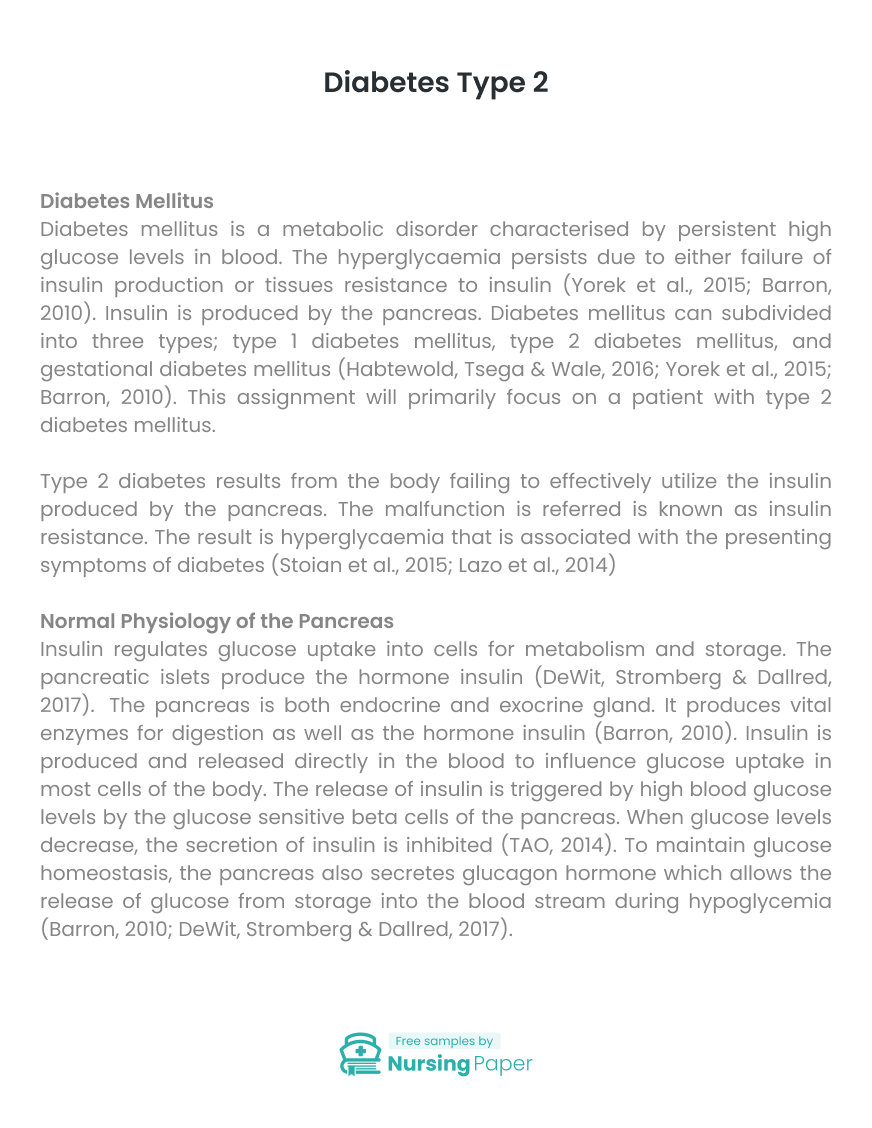1. Barron, J., 2010. The Endocrine System: The Pancreas & Diabetes. [Online]
Available at: https://jonbarron.org/diabetes-blood-sugar-levels/endocrine-system-pancreas-diabetes. [Accessed 21 October 2016].
2. Chin, Y, Huang, T, & Hsu, BR 2013, ‘Impact of action cues, self-efficacy and perceived barriers on daily foot exam practice in type 2 diabetes mellitus patients with peripheral neuropathy’, Journal of Clinical Nursing, vol. 22, no. 1/2, pp. 61-68. Available from: 10.1111/j.1365-2702.2012.04291.x. [8 February 2017].
3. DeWit, S. C., Stromberg, H., & Dallred, C. (2017). Medical-surgical nursing: Concepts & practice.
4. Habtewold, TD, Tsega, WD, & Wale, BY 2016, ‘Diabetes Mellitus in Outpatients in Debre Berhan Referral Hospital, Ethiopia’, Disease Markers, pp. 1-6. Available from: 10.1155/2016/3571368. [8 February 2017].
5. HINKLE, J. L., & CHEEVER, K. H. (2014). Brunner & Suddarth’s textbook of medical-surgical nursing.
6. Lazo, MA, Bernabé-Ortiz, A, Pinto, ME, Ticse, R, Malaga, G, Sacksteder, K, Miranda, JJ, & Gilman, RH 2014, ‘Diabetic Peripheral Neuropathy in Ambulatory Patients with Type 2 Diabetes in a General Hospital in a Middle Income Country: A Cross-Sectional Study’, PLoS ONE, vol. 9, no. 5, pp. 1-5. Available from: 10.1371/journal.pone.0095403. [7 February 2017].
7. Li, G, Sun, C, Wang, Y, Liu, Y, Gang, X, Gao, Y, Li, F, Xiao, X, & Wang, G 2014, ‘A Clinical and Neuropathological Study of Chinese Patients with Diabetic Peripheral Neuropathy’, PLoS ONE, vol. 9, no. 3, pp. 1-5. Available from: 10.1371/journal.pone.0091772. [8 February 2017].
8. Park, H, Park, C, Quinn, L, & Fritschi, C 2015, ‘Glucose control and fatigue in type 2 diabetes: the mediating roles of diabetes symptoms and distress’, Journal of Advanced Nursing, vol. 71, no. 7, pp. 1650-1660. Available from: 10.1111/jan.12632. [8 February 2017].
9. Stoian, A, Bănescu, C, Bălaşa, RI, Moţăţăianu, A, Stoian, M, Moldovan, VG, Voidăzan, S, & Dobreanu, M 2015, ‘Influence of GSTM1, GSTT1, and GSTP1 Polymorphisms on Type 2 Diabetes Mellitus and Diabetic Sensorimotor Peripheral Neuropathy Risk’, Disease Markers, vol. 2015, pp. 1-10. Available from: 10.1155/2015/638693. [6 February 2017].
10. Syngle, A, Verma, I, Krishan, P, Garg, N, & Syngle, V 2014, ‘Minocycline improves peripheral and autonomic neuropathy in type 2 diabetes: MIND study’, Neurological Sciences, vol. 35, no. 7, pp. 1067-1073. Available from: 10.1007/s10072-014-1647-2. [7 February 2017].
11. TAO, Y.-X. (2014). Glucose homeostatis and the pathogenesis of diabetes mellitus.
12. Won, JC, Kwon, HS, Kim, CH, Lee, JH, Park, TS, Ko, KS, & Cha, BY 2012, ‘Prevalence and clinical characteristics of diabetic peripheral neuropathy in hospital patients with Type 2 diabetes in Korea’, Diabetic Medicine: A Journal Of The British Diabetic Association, vol. 29, no. 9, pp. e290-e296. Available from: 10.1111/j.1464-5491.2012.03697.x. [8 February 2017].
13. Yorek, MS, Obrosov, A, Shevalye, H, Holmes, A, Harper, MM, Kardon, RH, & Yorek, MA 2015, ‘Effect of diet-induced obesity or type 1 or type 2 diabetes on corneal nerves and peripheral neuropathy in C57Bl/ 6J mice’, Journal of the Peripheral Nervous System, vol. 20, no. 1, pp. 24-31. Available from: 10.1111/jns.12111. [6 February 2017].

The download will start shortly.






 Subject:
Subject:
 Number of pages: 5
Number of pages: 5